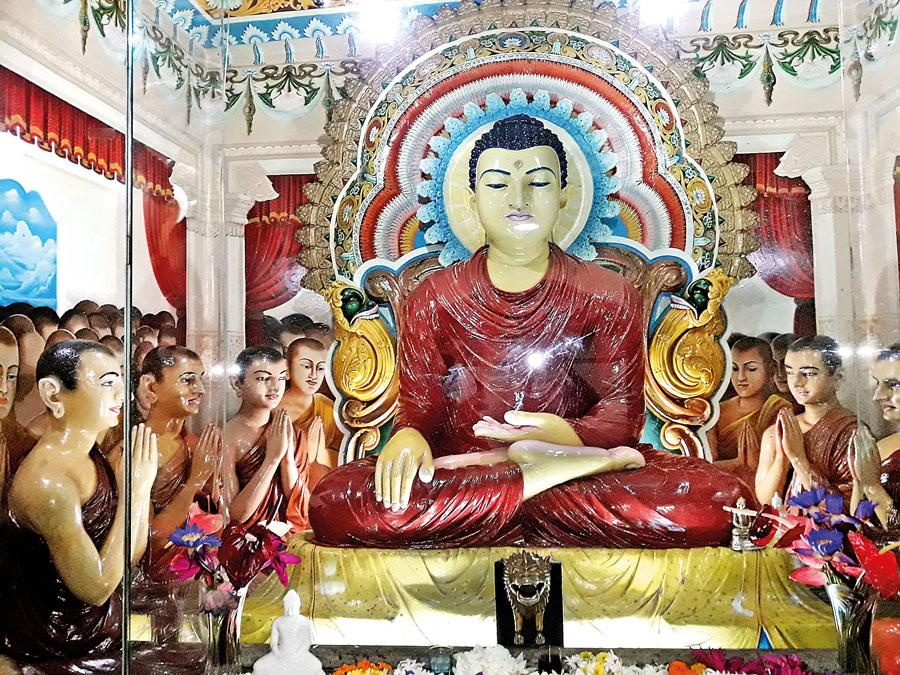Reply To:
Name - Reply Comment

There are these two extremes (anta), O Bhikkhus, which should be avoided by one who has renounced (Pabbajitena) –
1.Kama Sukallikanuyoga - Indulgence in sensual pleasures – this is base, vulgar, worldly, ignoble and profitless
2.Attakilamatanuyoga - Addiction to self-mortification – this is painful, ignoble and profitless
The late Alex Robertson, renowned lay preacher, explained that the Buddha in the fourth week after enlightenment contemplated on the subtleties and intricacies of His doctrine, its majesty and beauty
 Millions of devoted Buddhists worldwide annually celebrate the Vesak Full Moon Poya Day as an event of sacred triple significance. Prince Siddhartha Gautama was born 2,483 years ago on Vesak Full Moon Day at Kapilawastupura.
Millions of devoted Buddhists worldwide annually celebrate the Vesak Full Moon Poya Day as an event of sacred triple significance. Prince Siddhartha Gautama was born 2,483 years ago on Vesak Full Moon Day at Kapilawastupura.
Renouncing the worldly life, the prince became an ascetic in retreat for six long years in search of sublime truth to eradicate eternal suffering of all beings. On another Vesak Full Moon Day and at the age of 35, the Ascetic Gautama attained enlightenment as Thathagatha Gautama.
On reaching his 80th birthday and fulfilling duties as the Buddha for 45 years, the Buddha determined to recline at LumbiniParkin Kusinara2,563 years ago on yet another Vesak Full Moon Day.
“Siddhartha Gautama was a unique personality born to this world to uplift the virtues of others out of compassion for the happiness and benefit of human and divine beings” – (Ven. Narada Maha Thera).
Upon his enlightenment and ending the significant 49 days Sath Sathi, Sakyamuni Thathagatha resolved to visit the Isipathana Deer Park near Banaras where his former colleagues – the five great ascetics Kondanna, Bhadiya, Vappa, Mahanama and Assaji – lived.
Thereupon, the Exalted One addressed his first five disciples:
“There are these two extremes (anta), O Bhikkhus, which should be avoided by one who has renounced (Pabbajitena) –
1.Kama Sukallikanuyoga - Indulgence in sensual pleasures – this is base, vulgar, worldly, ignoble and profitless
2. Attakilamatanuyoga - Addiction to self-mortification – this is painful, ignoble and profitless
Abandoning both these extremes, the Thathagatha has comprehended the Middle Path (Majjhima Patipada) which promotes sight (cakkhu) and knowledge (gnana), and which tends to peace (vupasamaya), higher wisdom (abhinnaya), enlightenment (sambodhaya) and Nibbana.
What, O Bhikkhus, is that Middle Path the Thathagatha has comprehended which promotes sight and knowledge, and which tends to peace, higher wisdom, enlightenment, and Nibbana?
The very Noble Eightfold Path namely, right understanding (samma ditthi), right thoughts (samma samkappa), right speech (samma vaca), right action (samma kammanta), right livelihood (samma ajiva), right effort (samma vayama), right mindfulness (samma sati) and right concentration (samma Samadhi) - This, O Bhikkhus, is the Middle Path which the Thathagatha has comprehended.”
The Buddha preached: Now, this, O Bhikkhus is the noble truth of suffering (dukkha-ariya-sacca).
Birth is suffering, decay is suffering, disease is suffering, death is suffering, to be united with the unpleasant is suffering, to be separated from the pleasant is suffering, not to get what one desires is suffering. In brief, the five aggregates of attachment are suffering.
Now, this, O Bhikkhus, is the noble truth of the cause of suffering (dukkha-samudaya-ariyasacca):
It is this craving which produces rebirth (ponobhavika), accompanied by passionate clinging, welcoming this and that (life). It is the craving for sensual pleasures (kamatanha), craving for existence (bhavatanha) and craving for non-existence (vibhavatanha).
Now, this, O Bhikkhus, is the noble truth of the cessation of suffering (dukkha-nirodha-ariyasacca):
It is the complete separation from, and destruction of, this very craving, its forsaking, renunciation, the liberation therefrom and non-attachment thereto.
Now, this, O Bhikkhus, is the noble truth of the path leading to the cessation of suffering (dukkha-nirodha-gamini-patipada-ariya-sacca).
It is this Noble Eightfold Path namely right understanding, right thoughts, right speech, right action, right livelihood, right effort, right mindfulness and right concentration.
1. “This is the Noble Truth of Suffering.”
Thus, O Bhikkhus, with respect to things unheard before, there arose in me the eye, the knowledge, the wisdom, the insight and the light.
“This noble truth of suffering should be perceived (parinneyya).”
Thus, O Bhikkhus, with respect to things unheard before, there arose in me the eye, the knowledge, the wisdom, the insight and the light.
“This noble truth of suffering has been perceived (parinnata).”
Thus, O Bhikkhus, with respect to things unheard before, there arose in me the eye, the knowledge, the wisdom, the insight and the light.
2. “This is the Noble Truth of the Cause of Suffering.”
Thus, O Bhikkhus, with respect to things unheard before, there arose in me the eye, the knowledge, the wisdom, the insight and the light.
“This noble truth of the cause of suffering should be eradicated (pahatab ba).”
Thus, O Bhikkhus, with respect to things unheard before, there arose in me the eye, the knowledge, the wisdom, the insight and the light.
“This noble truth of the cause of suffering has been eradicated (pahinan).”
Thus, O Bhikkhus, with respect to things unheard before, there arose in me the eye, the knowledge, the wisdom, the insight and the light.
3. “This is the Noble Truth of Cessation of Suffering.”
Thus, O Bhikkhus, with respect to things unheard before, there arose in me the eye, the knowledge, the wisdom, the insight and the light.
“This noble truth of the cessation of suffering should be realized (sacchikatab ba).”
Thus, O Bhikkhus, with respect to things unheard before, there arose in me the eye, the knowledge, the wisdom, the insight and the light.
“This noble truth of the cessation of suffering has been realized (sacchikatam).”
Thus, O Bhikkhus, with respect to things unheard before, there arose in me the eye, the knowledge, the wisdom, the insight and the light.
4. “Thus is the Noble Truth of the Path leading to the Cessation of Suffering.”
Thus, O Bhikkhus, with respect to things, unheard before, there arose in me the eye, the knowledge, the wisdom, the insight and the light.
“This noble truth of the path leading to the cessation of suffering should be developed (bhavetab bam).”
Thus, O Bhikkhus, with respect to things unheard before, there arose in me the eye, the knowledge, the wisdom, the insight and the light.
“This noble truth of the path leading to the cessation of suffering has been developed (bhavitam).”
Thus, O Bhikkhus, with respect to things unheard before, there arose in me the eye, the knowledge, the wisdom, the insight and the light.
(Declaring His discourse the Buddha said):
As long, O Bhikkhus, as the absolute true intuitive knowledge regarding these Four Noble Truths under their three aspects and twelve modes was not perfectly clear to me, so long I did not acknowledge in this world inclusive of Gods, Maras and Brahmas and amongst the hosts of ascetics and priests, gods and men, that I had gained the incomparable supreme enlightenment (anuttaram samma-sam bodhim).
When, O Bhikkhus, the absolute true intuitive knowledge regarding these Four Noble Truths under their three aspects and twelve modes, became perfectly clear to me, then only did I acknowledge in this world inclusive of Gods, Maras, Brahmas, amongst the hosts of ascetics and priests, Gods and men, that I had gained the Incomparable supreme enlightenment.
And there arose in me the knowledge and insight (gnanadassana) – “Unshakable is the deliverance of my mind. This is my last birth and now there is no existence again.”
Thus, the Exalted One discoursed and the delighted Bhikkhus applauded the words of the Exalted One.
When this doctrine was being expounded, there arose in the Venerable Kondanna the dustless, stainless, truth-seeing eye (Dhammacakkhu) and he saw that “whatever is subject to origination, all that is subject to cessation.”
When the Buddha expounded the discourse of the Dhammacakka, the earth-bound deities exclaimed: “This excellent Dhammacakka, which could not be expounded by any ascetic, priest, God, Mara or Brahma in this world has been expounded by the Exalted One at the IsipatanaDeer Park near Banaras.”
Hearing this, the Devas Catummaharajika, Tavatimsa, Yama, Tusita, Nimmanarati, Paranimmitavasavatti and the Brahmas of Brahma Parisajja, Brahma Purohita, Maha Brahma, Parittabha, Appamanabha, Abhassara, Parittasubha, Appamanasubha, Subhakinna, Vehapphala, Aviha, Atappa, Sudassa, Sudassi and Akanittha raised the same joyous cry.
Thus, at that very moment, this cry extended as far as the Brahma realm. Ten thousand world systems quaked, tottered and trembled violently.
A radiant light surpassing the effulgence of the Gods appeared in the world. Then, the Exalted One said: “Friends, Kondanna has indeed understood. Friends, Kondanna has indeed understood.”
Therefore, the Venerable Kondanna was named Annata Kondanna.
The Buddha Rays:
The late Alex Robertson, renowned lay preacher, explained that the Buddha in the fourth week after enlightenment contemplated on the subtleties and intricacies of His doctrine, its majesty and beauty, particularly on MAHA PATTHANA which deals with the twenty four casual relations relating to all mental and physical phenomena that He experienced ECSTATIC BLISS and UNALLOYED happiness.
The intensity of this serene joy and pious emotion was so overwhelming that it permeated His entire GOLDEN – HUED BODY and the Six-Coloured Glorious Rays emanated from the body downwards penetrating earth, water and air, and further blazed forth upwards like the rays of the glorious sun into the different realms of existence extending as far as sphere of neither perception and non-perception.”
This rare and extraordinary phenomenon is thus described as ‘Buddha Rashmi.’
“The purity and sublimity, the serenity and tranquility, of His mind generated sparkling and wholesome material qualities which left their imprint on His personality and the colour of His blood became pure, pellucid and clear, and as a result, rays of six colours – Indigo, Gold, Red, White, Tawny and Dazzling issued from the body of the Blessed One.”
Great Compassion:
A special knowledge of the Compassionate One is MAHA – KARUNA SAMAPATTI – NANA – knowledge of great compassion:
“For two hours in the morning and two hours before noon, He radiated boundless compassion to all beings which blazes forth like the rays of the glorious sun, and finds out to whom He could render spiritual service and direct the weary wayfarer on the proper road. With this special knowledge He has transformed the lives of numerous beings, Gods, Maras, men, animals, ghosts, demons and helped them to attain the blissful states of existence and the goal of final emancipation.”
Sadhu… Sadhu … Sadhu …